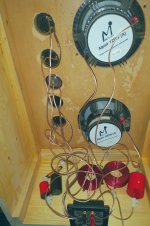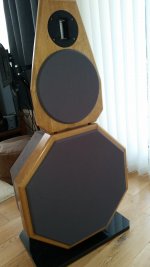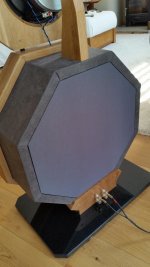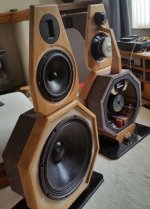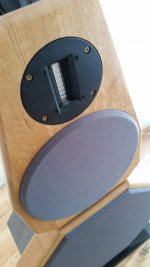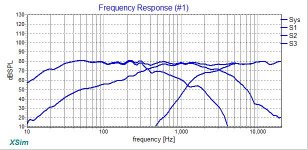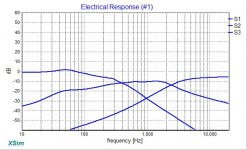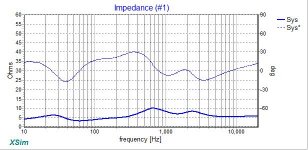@perrymarshall: Very interesting design and your enthusiasm for your creations is infectious! Is the wavey edge of the baffle just how the wood came or is it by design? Also have you thought about upgrading from MiniDSP to Audiolense or Acourate? Mitch Barnett will tell you that those software DSP solutions are in a different league to all hardware based solutions. Maybe something to try if you tri-amp them ?
I was expecting a different sound and approach.
But, they are simply better in all areas. Period.
Better detail and resolution, better sound stage, wider listening window....basically better than anything I have ever build or heard in all metrics.
Everyone who has heard them agrees. And I have gotten everyone to have a listen to make sure I wasn't going mad....
It was a complete surprise to me. I was actually upset by this as I love my synergies and my spherical multiways and had put so much work and planning into building them.
That’s impressive. And very cool looking speakers I might add!
eh, miniDSP is also software. 
but it means that you have to do all the work to measure, tweak FR and phase, and import those FIR files into the miniDSP unit. More work, but also more control over the filtering.
Audiolense and Acourate are a little like Dirac, right?
They measure, apply filters for you.. you just need to sit back, and let them do their thing.
but it means that you have to do all the work to measure, tweak FR and phase, and import those FIR files into the miniDSP unit. More work, but also more control over the filtering.
Audiolense and Acourate are a little like Dirac, right?
They measure, apply filters for you.. you just need to sit back, and let them do their thing.
eh, miniDSP is also software.
but it means that you have to do all the work to measure, tweak FR and phase, and import those FIR files into the miniDSP unit. More work, but also more control over the filtering.
Audiolense and Acourate are a little like Dirac, right?
They measure, apply filters for you.. you just need to sit back, and let them do their thing.
mmm...yes, they are all softwares, just like Ferrari and a Fiat are all cars
I've been using Acourate for years and very familiar with it. Very advanced, super flexible but not so easy to use and has relatively little automation. Automated enough I guess. I use it to create digital crossovers, time alignment, room correction, currently using it for dipoles, so the compensation is done within. I've been in touch with Mitch Barnett on this since he wrote his first articles at Computeraudiophile.com about 7 or 8 years ago. Since then he has tried Audiolense, which he shared is as sophisticated as Acourate but is more automated so easier to get through the learning curve. Acourate standard can be applied to 2-channel or up to 5-ways (10 channels). I believe for Audiolense you have a less expensive 2-channel version and a more expensive multichannel. I use 4-way stereo, so 8 channels.
Dirac is a lot easier to use than Acourate, but a lot more limited, less sophisticated and less flexible.
I'm not familiar with MiniDSP, but is not mentioned among the more advanced softwares as far as I recall.
Importantly, for multiway you need multiple amps but also a multichannel DAC, a measuring mic and ADC. Or multiple digital amps and a multichannel digital converter. I use a Lynx Hilo for ADC/DAC, like Mitch. Uli, the man behind Acourate, uses digital amps with a multichannel digital converter.
With these softwares you derive digital filters that then get used for example in Roon for convolution during listening. Works great.
I found external hardware solution to be more convenient to use. miniDSP FIR is not too bad if you only use FIR for a 2-way speaker. It doesn't have enough taps to really do anything more than that. With miniDSP I like that I don't have to worry about the PC drivers ect when switching between apps like youtube, amazon, VLC, jriver ect. And the rest of the family like the remote for volume. PC volume gets trickier.
But if you are looking to flatten phase for a 3 or 4 way speaker, the PC is a place for that.
But if you are looking to flatten phase for a 3 or 4 way speaker, the PC is a place for that.
I used Eclipse software to generate the FIR filters and loaded them in to MiniDSP. Have not tried other software or platforms.
The wood was as-is, with some cleanup by the carpenter.
If I tri-amped I would need more FIR taps than the MiniDSP 2x4HD provides.
The wood was as-is, with some cleanup by the carpenter.
If I tri-amped I would need more FIR taps than the MiniDSP 2x4HD provides.
@perrymarshall: Very interesting design and your enthusiasm for your creations is infectious! Is the wavey edge of the baffle just how the wood came or is it by design? Also have you thought about upgrading from MiniDSP to Audiolense or Acourate? Mitch Barnett will tell you that those software DSP solutions are in a different league to all hardware based solutions. Maybe something to try if you tri-amp them ?
OK, but still can do that with a computer, JRiver and DRC app, as wesayso has proven in his lengthy Two Towers thread.
I'm not dismissing either Acourate nor Audiolense, I'm just saying there are options.
Yes, there is several softwares paid and free. Limited list is listed here
Convolution - JRiverWiki
Any convolution engine can be used.
Old school multiway
An amplifier packed it in recently, and I got to thinking an old school speaker without active crossovers or DSP might be a good thing.
This is an existing speaker I converted to all passive yesterday using only spare parts.
Series parallel wiring lets the tweeters cross as low as 900 Hz, so this was a chance to hear how they do with six slopes, and through the rest of the speaker.
Similar bandpassing as with its active version.
Deep bass isn't crossed over, just 60 hertz augmented 4 slope, from 2 spread sealed subs.
Nice low parts count, and I don't feel like the sound lost a thing using just a single small amp on them .
Pretty decent bass with no subs on music, but Godzilla's a lightweight without sub help.
Only one tweeter is used as a tweeter, and it got some acoustic foam beside it to limit sidewall reflections a little.
An amplifier packed it in recently, and I got to thinking an old school speaker without active crossovers or DSP might be a good thing.
This is an existing speaker I converted to all passive yesterday using only spare parts.
Series parallel wiring lets the tweeters cross as low as 900 Hz, so this was a chance to hear how they do with six slopes, and through the rest of the speaker.
Similar bandpassing as with its active version.
Deep bass isn't crossed over, just 60 hertz augmented 4 slope, from 2 spread sealed subs.
Nice low parts count, and I don't feel like the sound lost a thing using just a single small amp on them .
Pretty decent bass with no subs on music, but Godzilla's a lightweight without sub help.
Only one tweeter is used as a tweeter, and it got some acoustic foam beside it to limit sidewall reflections a little.
Attachments
Youtube and a recording with a phone does not do the speakers any justice i think. But it sounds pretty OB and close to the sound i get from my OB projects. It is impossible to judge sound from youtube and especially bottom end extension and precision which is the real OB challenge. I never found it difficult to get mids and highs very good in OB configuration. But i never used anything other than top shelf drivers.
This speaker is not fully open baffle. The poster mentions a 50 litre cabinet for the bass drivers.
I'm sure he is aware, but it's his thread. 
(..and its not like all manner of others have spammed the crap out of this thread with posts that do not contain pictures/video of open baffle loudspeakers.)
Oh, and about that non-open baffle loudspeaker in the video: I've also posted about it before - it's rather good reproduction, MUCH better than in the open baffle video (..and ironically, MUCH better than the Troel's designed loudspeakers that replaced those seen in the video).
(..and its not like all manner of others have spammed the crap out of this thread with posts that do not contain pictures/video of open baffle loudspeakers.)
Oh, and about that non-open baffle loudspeaker in the video: I've also posted about it before - it's rather good reproduction, MUCH better than in the open baffle video (..and ironically, MUCH better than the Troel's designed loudspeakers that replaced those seen in the video).
This design looks really good, I looked at the comments of this video, but could not find out more
Here is my latest open baffle design/build.
Drivers are Beta15a, Seas U22 and Aurum Cantus G2si and there's a second tweeter on the rear as I prefer that to just a single front one.
My previous OB which was on a single, larger baffle used open-backed Mundorf AMT with Seas U18 and Alpha 15a and though I like the Alpha very much but the Beta does seem to sound cleaner. Overall the sound is very smooth, clean and transparent

Drivers are Beta15a, Seas U22 and Aurum Cantus G2si and there's a second tweeter on the rear as I prefer that to just a single front one.
My previous OB which was on a single, larger baffle used open-backed Mundorf AMT with Seas U18 and Alpha 15a and though I like the Alpha very much but the Beta does seem to sound cleaner. Overall the sound is very smooth, clean and transparent


Attachments
- Home
- Loudspeakers
- Multi-Way
- Ultimate Open Baffle Gallery
